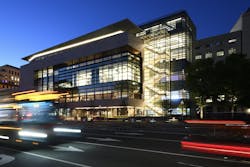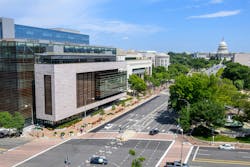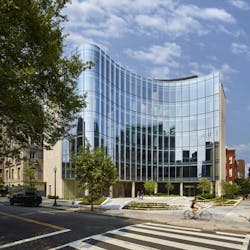Southern California evokes images of sunshine, palm trees and beaches. But that’s not the vibe at the newest campus of the University of Southern California. A continent away from surfboards and the sands of the Pacific Ocean, USC’s Capital Campus in Washington, D.C., which opened last year, is more focused on the ebb and flow of politics and government policy.
USC is one of several universities that have been claiming space close to the levers of power in the nation’s capital. The city is home to several prestigious universities—Georgetown, George Washington, Howard, and American to name a few—but many other higher education institutions have a local presence. The District of Columbia’s Higher Education Licensure Commission lists more than 100 schools with degree programs that are approved to operate in Washington, D.C.
Having programs or more substantial satellite campuses in Washington, D.C. enables those schools to give students more opportunities to observe government in action and interact with researchers and policymakers. And for those drawn toward careers in the public sector, the hands-on experience among the movers and shakers in the nation’s capital gives them a leg up.
Of the universities that have recently expanded their Washington, D.C., footprint, the ones making the biggest splash are Johns Hopkins University and the University of Southern California. Each of those institutions has taken advantage of existing office space available for sale and invested millions of dollars to establish a significant satellite campus that announces their intention to be more active participants in the nation’s public policy and research discussions.
Museum makeover
Johns Hopkins University’s main campus in Baltimore is close to Washington, D.C.—only about 40 miles north—but the university desired to be a bigger player in the political and governmental activities in the nation’s capital.
Its quest for a more visible presence in Washington coincided with the decline and eventual demise of another city attraction—the Newseum, a $450 million museum dedicated to journalism that opened in 2008 on Pennsylvania Avenue between the White House and the U.S. Capitol. The Newseum shut down at the end of 2019, and Johns Hopkins stepped forward to acquire the facility for $372.5 million. Then it ponied up an additional $275 million to renovate the former museum and covert it to an education facility.
The result is the Johns Hopkins University Bloomberg Center at 555 Pennsylvania Ave. It officially opened in October 2023.
The 435,000-square-foot facility houses the School of Advanced International Studies, Carey Business School, the Krieger School of Arts and Sciences, Peabody Institute, and the newly established School of Government and Policy.
The 10-story steel and glass building features 38 high-tech classrooms, the university says. Other amenities include a lounge-style library; a multimedia studio; 435 seats available for informal study; 26 enclosed study rooms; a 375-seat theater with sound-absorbing walls for music performances and a sprung stage for dance; an art gallery; three floors of conference center space; a banquet hall; a fitness and wellness center; and landscaped roof terraces.
"The Hopkins Bloomberg Center's design embodies its purpose—a single, dynamic space that brings together all the university's divisions, offering opportunities for collaboration and innovation on significant policy issues to better serve the nation and the world," said Johns Hopkins University President Ronald J. Daniels.
Ennead Architects designed the renovations of the former museum in collaboration with Rockwell Group and SmithGroup. The updates simplified and reorganized the Newseum’s building plan. Originally intended to accommodate highly specialized exhibits, the revised design reconfigures the floorplates to increase the building’s square footage and modifies building systems to support Johns Hopkins’ programs and sustainability goals.
Go East
Spurred by the rallying cry “Go West,” thousands of pioneers traversed the continent in the 1800s and eventually arrived in California.
But for students and faculty at the University of Southern California’s new Capital Campus in Washington, D.C., it’s a bit of a reverse commute—more than 2,600 miles to the east.
USC bought the 60,000-square-foot building at 1771 N St. NW for $49.4 million in 2023. The facility previously housed the headquarters for the National Association of Broadcasters. USC’s sizeable presence in the heart of the city provides an East Coast anchor for the prominent West Coast institution.
Officials say the Capital Campus puts the university at the center of global political and policy discussions and will serve as the university’s link to nearby embassies and diplomatic outposts.
“We believe that a city like Washington, D.C., with a vibrant mix of government, the arts, public policy organizations, research agencies and foundations is ideal for our expanded presence,” says Brian K. Wilson, director of USC Real Estate and Development.
The university had been leasing space in two buildings in downtown Washington and had been looking at several possible sites for the Capital Campus when it became aware of 1771 N Street NW, Wilson said.
“We did not consider constructing a new building given the high cost to do so and the relatively low pricing for existing buildings,” Wilson says. “1771 N Street NW had been recently renovated and was available at an attractive price.”
Before the building was purchased by USC, the HOK architecture firm designed an extensive renovation that included a six-story glass façade, rejuvenated outdoor spaces and interior improvements. HOK says the renovation received a LEED Gold certification and reduces the building’s energy and water use by 35%.
It has modern office space, multiple event venues and an outdoor terrace offering panoramic views of the city skyline. It also will house the USC Office of Research Advancement, which helps faculty researchers secure federal funding for research projects.
This year, USC announced the first major research and education facility to be headquartered at the Capital Campus. It has established the USC Leonard D. Schaeffer Institute for Public Policy & Government Service.
The institute represents an expansion of two programs—the USC Schaeffer Center for Health Policy & Economics and the Leonard D. Schaeffer Fellows in Government Service. A $59 million donation from Leonard D. Schaeffer and his wife, Pamela, will pay for a build-out of the seventh floor of the Capital Campus, which be dedicated to the Schaeffer Institute. The institute also will have offices on the USC campus in Los Angeles.
Having the institute in Washington, D.C., will enable scholars to more easily and frequently share fact-based policy solutions with public- and private-sector leaders, the university says.
“The Schaeffer Institute will be an invaluable resource for education and scholarship, not just for Schaeffer scholars and its affiliated experts but for faculty members and students from multiple disciplines across USC,” says Dana Goldman, dean of USC Sol Price School of Public Policy and co-director of the USC Schaeffer Center. “Their ability to use our Capital Campus office to more easily engage with policymakers will give them far more impact.”
Mike Kennedy ([email protected]) is senior editor of AS&U.
Sidebar:
Planting a flag in D.C.
Here are some of the other universities that have put down stakes in the nation’s capital:
Texas A&M University: The Bush School of Government and Public Service was founded in 1997 on the College Station campus. Named for former President George H.W. Bush, the school offers graduate programs such as Public Service and Administration, International Affairs, and International Policy, so it made sense when the school decided to expand to Washington, D.C., in 2021.
Its location at 1620 L St. NW has almost 47,000 square feet of space across five floors, and is just a few blocks from the White House and other key governmental agencies.
“This enables Bush School students to study near the most prominent members of the national security community, including the FBI, CIA, NSA, State Department and Pentagon, and think tanks,” the Bush School’s website says.
The space has classrooms, conference rooms, study lounges, and collaborative/huddle rooms; an admissions center, catering kitchen, snack and beverage stations, and a 150-seat theater/lecture hall.
Arizona State University: The university opened its flagship Washington, D.C., facility—the ASU Barbara Barrett and Sandra Day O’Connor Washington Center—in 2018. The building, a converted apartment building, expanded ASU’s presence in the nation’s capital, and provides additional learning, teaching and research opportunities for students and faculty members.
The center houses the Washington Bureau of the Walter Cronkite School of Journalism and Mass Communication, the Sandra Day O’Connor College of Law Rule of Law and Security program, the Capital Scholars program, and the McCain Institute’s Global Leaders program, among others.
Princeton University: The Princeton School of Public and International Affairs leased a Washington, D.C., location in 2023 to provide students and faculty with a closer connection to policymakers.
The school’s site at 1333 New Hampshire Ave. NW has more than 6,700 square feet of office space: a conference room, offices, a reception area, and a pantry/kitchen, and an open area of 600-plus square feet for gatherings. The building also has a rooftop area with views of downtown Washington, and indoor and outdoor spaces that can accommodate almost 490 people for larger events.
About the Author
Mike Kennedy
Senior Editor
Mike Kennedy has been writing about education for American School & University since 1999. He also has reported on schools and other topics for The Chicago Tribune, The Kansas City Star, The Kansas City Times and City News Bureau of Chicago. He is a graduate of Michigan State University.


